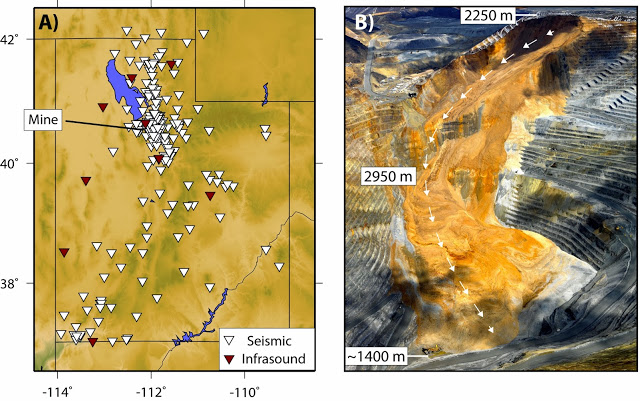
Landslides are one of the most hazardous aspects of our planet, causing billions of dollars in damage and thousands of deaths each year. Most large landslides strike with little warning—and thus geologists do not often have the ability to collect important data that can be used to better understand the behavior of these dangerous events. The 10 April 2013 collapse at Kennecott’s Bingham Canyon open-pit copper mine in Utah is an important exception.
Careful and constant monitoring of the conditions of the Bingham Canyon mine identified slow ground displacement prior to the landslide. This allowed the successful evacuation of the mine area prior to the landslide and also alerted geologists at the University of Utah to enable them to successfully monitor and study this unique event.
The landslide—the largest non-volcanic landslide in the recorded history of North America—took place during two episodes of collapse, each lasting less than two minutes. During these events about 65 million cubic meters of rock—with a total mass of 165 million tons—collapsed and slid nearly 3 km (1.8 miles) into the open pit floor.
In the January 2014 issue of GSA Today, University of Utah geologists, led by Dr. Kristine Pankow, report the initial findings of their study of the seismic and sound-waves generated by this massive mega-landslide. Pankow and her colleagues found that the landslide generated seismic waves that were recorded by both nearby seismic instruments, but also instruments located over 400 km from the mine. Examining the details of these seismic signals, they found that each of the two landslide events produced seismic waves equivalent to a magnitude 2 to 3 earthquake.
Interestingly, while there were no measurable seismic events prior to the start of the landslide, the team did measure up to 16 different seismic events with characteristics very much like normal “tectonic” earthquakes beneath the mine. These small (magnitude less than 2) earthquakes happened over a span of 10 days following the massive landslide and appear to be a rare case of seismic activity triggered by a landslide, rather than the more common case where an earthquake serves as the trigger to the landslide.
Later studies of both the seismic and sound waves produced by this landslide will allow Pankow and her team to characterize the failure and displacement of the landslide material in much more detail.
Note : The above story is based on materials provided by Geological Society of America










